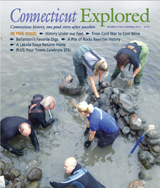By Elizabeth J. Normen
(c) Connecticut Explored Inc. Summer 2014
Subscribe/Buy the Issue!
 2014 marks the 400th anniversary of Adriaen Block’s 1614 voyage up the Connecticut River. Block is credited as being the first European to explore the interior of Connecticut. Unlike the English settlers who arrived 20 years later, Block and his crew weren’t looking for arable land or for a place to settle and worship as they chose: They were scouting for beaver pelts to trade. The rise and fall of demand for—and the over-trapping of—Castor canadensis, the North American beaver, largely explains why the Dutch role in founding Connecticut was so short-lived.
2014 marks the 400th anniversary of Adriaen Block’s 1614 voyage up the Connecticut River. Block is credited as being the first European to explore the interior of Connecticut. Unlike the English settlers who arrived 20 years later, Block and his crew weren’t looking for arable land or for a place to settle and worship as they chose: They were scouting for beaver pelts to trade. The rise and fall of demand for—and the over-trapping of—Castor canadensis, the North American beaver, largely explains why the Dutch role in founding Connecticut was so short-lived.
In the 17th century the Dutch were already involved in global markets. After British explorer Henry Hudson sailed up the Hudson River in 1609 (looking for a western passage to Asia on behalf of the Dutch East India Company) and saw potential for fur trading with the Native Americans, the seasoned Captain Block returned to the area on several voyages between 1611 and 1614. Block discovered Long Island Sound—oddly enough, from the west end—via what’s now known as the East River. After a decade of fur trading in the area, the Dutch established a post at the mouth of the Connecticut River and another in 1633 near present-day Hartford at a spot that retained the name “Dutch Point” well into the 20th century.
In 1635-1636, the British (via Boston) settled Windsor, Hartford, and Wethersfield. To keep the peace, the Treaty of Hartford in 1650 gave all lands 50 Dutch miles west of the Connecticut River to the Dutch (New Amsterdam) and lands to the east to the British (New England.) The Dutch relinquished their claims in 1667 in exchange for concessions by the British in the Banda Islands of Indonesia. According to a theory posited by Johan Varekamp and Daphne Varekamp in “Adriaen Block” in Wrack Lines (UConn Sea Grant College Program, Spring/Summer 2006), by then, the Dutch had come to see spices as more valuable than beaver fur. Indeed, a drop in demand in Europe in the late 17th century had caused a glut of, and falling prices for, beaver pelts. With beaver populations becoming scarce in New England, Indonesian spices looked more promising, and the Dutch moved on.
Johan Varekamp, a science professor at Wesleyan University, and his daughter Daphne, then a Durham high-school student, also put forth an interesting theory as to why Connecticut became known as the Nutmeg State: “The nutmeg was the prime fruit of the Banda Islands,” they write, “where the hard pit was ground to obtain nutmeg powder, whereas the fruit was eaten in dried form. Is the nutmeg symbol a reflection of early Dutch influences?” Refresh your memory as to why some call us the Nutmeg State by re-reading state historian Walt Woodward’s essay from the Winter 2007/2008 issue.
The Summer 2014 Issue: Underground History
In this issue we explore stories that, figuratively or literally, reside underground. On the eve of his retirement, we invited state archaeologist Nick Bellantoni to reflect on his nearly three-decade career. We also look at some Cold War history, a War of 1812 relic discovered under water, the story of a Lakota Sioux buried here for nearly a century whose remains finally returned home, and more.
Dig in—and then head out this summer to explore the history right under your feet. Don’t forget that Connecticut at Work, Connecticut Humanities’s year-long exploration of the past, present, and future of work, continues. The Smithsonian traveling exhibition “The Way We Worked” is on view at the Mattatuck Museum in Waterbury from June 21 to August 3, 2014 and at Connecticut Landmarks’s Nathan Hale Homestead in Coventry from August 9 to September 14, 2014. (See page 51.)
